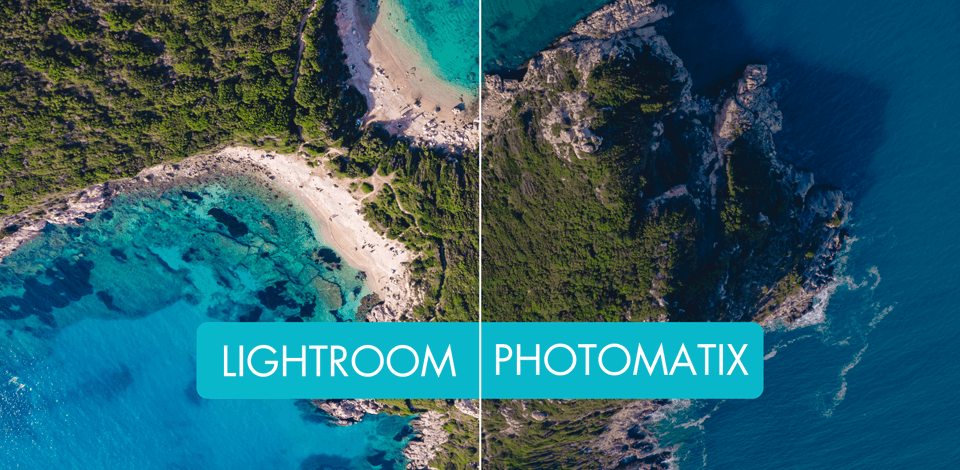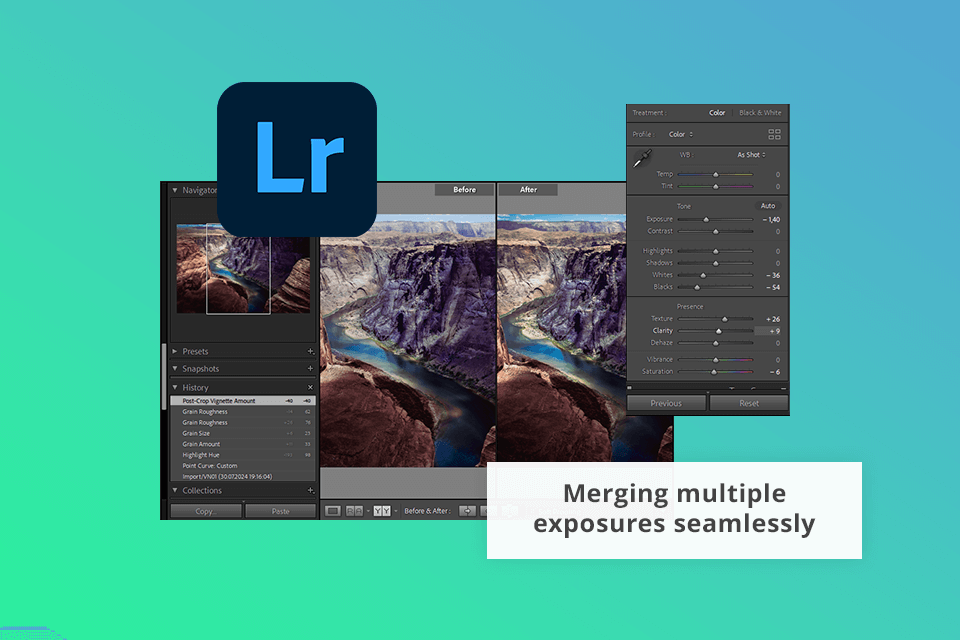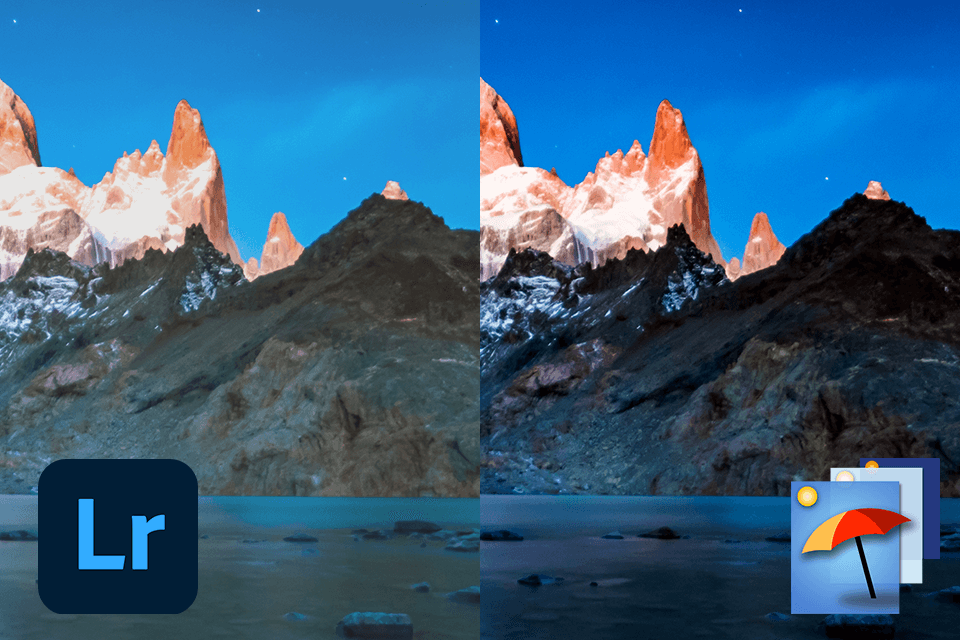
I decided to compare Photomatix vs Lightroom to see which software is more suitable for creating HDR images.
After testing both of them, I concluded that Lightroom is more suitable for those who want to quickly produce an HDR photo. The program has intuitive functionality, which makes it an excellent choice for beginners. Besides, it comes with handy organizational tools.
Nevertheless, Photomatix has more powerful features for creating HDR pics. The program utilizes advanced tone mapping algorithms, which makes it perfect for merging images with different exposures.
Even though Photomatix has a more advanced toolset for creating HDR photos and stands out for its customizable features, I decided to choose Lightroom as the winner of this comparison, as it stands out among other HDR software due to its extensive functionality. Besides, Lr presets can optimize your workflow and edit photos in a consistent style.

|
|

Photomatix |

Lightroom |
|
Rating |
★★★★☆ 4/5 |
★★★★☆ 4.5/5 |
|
Best For |
Creating HDR images with a realistic look |
General photo editing and image organization |
|
Free Trial |
✔️ |
✔️ |
|
Price |
$92 |
$9.99/mo |
|
Platforms |
Windows, Mac, Linux |
Windows, Mac, Web, iOS, Android |

You can download Photomatix for free to test out this software. It supports advanced editing and comes with a variety of presets that help me work on my projects more efficiently.
Even though the program has extensive functionality, it is difficult to master. Photomatix seamlessly merges photos with different exposures to create an HDR effect and make highlights and shadows more detailed. Using it, I can capture the beauty of sunsets, make colors richer, and ensure that the foreground looks sufficiently dark.
Photomatix integrates with other programs, including Lightroom and Photoshop, which makes it suitable for many uses and enables me to streamline my workflow. Merging images with different exposures and making highlights and shadows more nuanced allows getting real estate pics with perfect exposure levels.

Lightroom comes with handy HDR tools enabling me to merge images with different exposures to emphasize highlights and shadows. Even though Lightroom supports automated editing, I prefer to create HDR photos manually. However, you may use the available presets to save time and achieve a realistic HDR effect.
After making the Photomatix vs Lightroom HDR comparison, I concluded that the automated deghosting tools available in the latter do not allow me to achieve consistent results. This is why I limit the amount of editing and just merge separate frames when working in Lightroom.
I like the fact that the program integrates with Photoshop, which allows me to switch between them if I need to use more advanced editing tools.

Short answer: The output photos that I got after using Lightroom are more realistic than the results I achieved with the help of Photomatix. The latter allows me to make my HDR photos look like paintings.
Nevertheless, I was impressed by Photomatix’s deghosting tools, as they helped me reduce the number of artifacts that resulted from moving objects. These features are especially useful for those who want to capture waterfalls or landscapes during the windy weather.
Lightroom is better suited for producing natural-looking HDR effects, which makes it perfect for professionals who specialize in realistic photography. When testing this software, I was pleased by the quality of my pics. Its tools are perfect for editing landscape and real estate photos.
|
|

Photomatix |

Lightroom |
|
|
|
|
Free Trial |
✔️ |
✔️ |
|
|
|
|
Price |
$92 |
$9.99/mo |
|
|
|
|
Best Offer |
$92 |
Photography |
|
|
|
|
|

Photomatix |

Lightroom |
|
|
|
|
Lightroom |
✔️ |
✔️ |
|
|
|
|
Mac |
✔️ |
✔️ |
|
|
|
|
Linux |
✔️ |
❌ |
|
|
|
|
Web |
❌ |
✔️ |
|
|
|
|
iOS |
❌ |
✔️ |
|
|
|
|
Android |
❌ |
✔️ |
|
|
|
|
|

Photomatix |

Lightroom |
|
|
|
|
|
✔️ |
✔️ |
|
|
|
|
Live |
❌ |
✔️ |
|
|
|
|
Phone |
❌ |
✔️ |
|
|
|
|
Chat |
✔️ |
✔️ |
|
|
|
| Pros | Cons | Suitable for | |
|---|---|---|---|
|
Photomatix |
A variety of presets and customization options |
Some issues with tone mapping |
Creative photographers, timelapse photographers |
|
|
Quick merging |
Lacks professional editing tools |
|
|
|
Automated processes |
|
|
|
|
A range of tone-mapping options |
|
|
|
|
Seamless integration |
|
|
|
|
|
|
|
|
Lightroom |
Quick photo editing and file organization |
Slow processing with large catalogs |
People who like realistic HDR photography, landscape photographers |
|
|
A choice of editing tools |
Subscription-based |
|
|
|
Streamlined navigation |
|
|
|
|
Seamless integration with other software |
|
|
|
|
Supports batch processing |
|
|
I believe that Lightroom is a better choice as it comes with pro-level editing and organizational tools. Besides, it integrates with many third-party programs. Its merge tool is easy to use.
Even though the program has a more limited toolset than Photomatix, it allows users to control the intensity of the HDR effect and adjust the ghosting effect.
HDR photography necessitates taking multiple photos at the same location using different exposures and merging them together to produce a picture with a wide dynamic range and rich colors. If you compare Lightroom Enfuse vs Photomatix, you will see that both programs streamline this task and allow users to achieve an HDR effect.
Photomatix was built for those who need to produce High Dynamic Range (HDR) photos. It relies on complex tone mapping algorithms and supports a variety of rendering styles. At the same time, Lightroom has more extensive functionality and comes with a variety of photo editing and organizational tools.
Many seasoned photographers and photo editors use Photomatix for HDR photography as it comes with advanced tools that allow them to achieve a realistic HDR effect. Lightroom is also widely used by specialists as it has handy organizational tools and is compatible with other Adobe software.